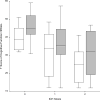Prophylactic Seizure Medication and Health-Related Quality of Life After Intracerebral Hemorrhage
- PMID: 29923930
- PMCID: PMC6095719
- DOI: 10.1097/CCM.0000000000003272
Prophylactic Seizure Medication and Health-Related Quality of Life After Intracerebral Hemorrhage
Abstract
Objectives: Prophylactic levetiracetam is currently used in ~40% of patients with intracerebral hemorrhage, and the potential impact of levetircetam on health-related quality of life is unknown. We tested the hypothesis that prophylactic levetiracetam is independently associated with differences in cognitive function health-related quality of life.
Design: Patients with intracerebral hemorrhage were enrolled in a prospective cohort study. We performed mixed models for T-scores of health-related quality of life, referenced to the U.S. population at 50 ± 10, accounting for severity of injury and time to follow-up.
Setting: Academic medical center.
Patients: One-hundred forty-two survivors of intracerebral hemorrhage.
Interventions: None.
Measurements and main results: T-scores of Neuro-Quality of Life Cognitive Function v2.0 was the primary outcome, whereas Neuro-Quality of Life Mobility v1.0 and modified Rankin Scale (a global functional scale) were secondary measures. We prospectively documented if prophylactic levetiracetam was administered and retrieved administration data from the electronic health record. Patients who received prophylactic levetiracetam had worse cognitive function health-related quality of life (T-score 5.1 points lower; p = 0.01) after adjustment for age (p = 0.3), National Institutes of Health Stroke Scale (p < 0.000001), lobar hematoma (p = 0.9), and time of assessment; statistical models controlling for prophylactic levetiracetam and the Intracerebral Hemorrhage Score, a global measure of intracerebral hemorrhage severity, yielded similar results. Lower T-scores of cognitive function health-related quality of life at 3 months were correlated with more total levetiracetam dosage (p = 0.01) and more administered doses of levetiracetam in the hospital (p = 0.03). Patients who received prophylactic levetiracetam were more likely to have a lobar hematoma (27/38 vs 19/104; p < 0.001), undergo electroencephalography monitoring (15/38 vs 21/104; p = 0.02), but not more likely to have clinical seizures (4/38 vs 7/104; p = 0.5). Levetiracetam was not independently associated with the modified Rankin Scale scores or mobility health-related quality of life (p > 0.1).
Conclusions: Prophylactic levetiracetam was independently associated with lower cognitive function health-related quality of life at follow-up after intracerebral hemorrhage.
Conflict of interest statement
The remaining authors have disclosed that they do not have any potential conflicts of interest.
Figures

Similar articles
-
Levetiracetam for Seizure Prophylaxis in Neurocritical Care: A Systematic Review and Meta-analysis.Neurocrit Care. 2022 Feb;36(1):248-258. doi: 10.1007/s12028-021-01296-z. Epub 2021 Jul 20. Neurocrit Care. 2022. PMID: 34286461
-
Early Seizures Are Predictive of Worse Health-Related Quality of Life at Follow-Up After Intracerebral Hemorrhage.Crit Care Med. 2021 Jun 1;49(6):e578-e584. doi: 10.1097/CCM.0000000000004936. Crit Care Med. 2021. PMID: 33729725 Free PMC article.
-
Prophylactic Anticonvulsants in Intracerebral Hemorrhage.Neurocrit Care. 2017 Oct;27(2):220-228. doi: 10.1007/s12028-017-0385-8. Neurocrit Care. 2017. PMID: 28324261 Free PMC article.
-
Why Physicians Prescribe Prophylactic Seizure Medications after Intracerebral Hemorrhage: An Adaptive Conjoint Analysis.J Stroke Cerebrovasc Dis. 2020 Apr;29(4):104628. doi: 10.1016/j.jstrokecerebrovasdis.2019.104628. Epub 2020 Feb 6. J Stroke Cerebrovasc Dis. 2020. PMID: 32033905 Free PMC article.
-
Guidelines for Seizure Prophylaxis in Patients Hospitalized with Nontraumatic Intracerebral Hemorrhage: A Clinical Practice Guideline for Health Care Professionals from the Neurocritical Care Society.Neurocrit Care. 2025 Feb;42(1):1-21. doi: 10.1007/s12028-024-02183-z. Epub 2024 Dec 21. Neurocrit Care. 2025. PMID: 39707127
Cited by
-
Effect of Primary Prophylactic Antiseizure Medication for Seizure Prevention Following Intracerebral Hemorrhage in the ERICH Study.J Stroke Cerebrovasc Dis. 2022 Jan;31(1):106143. doi: 10.1016/j.jstrokecerebrovasdis.2021.106143. Epub 2021 Oct 26. J Stroke Cerebrovasc Dis. 2022. PMID: 34715523 Free PMC article.
-
Phenotypes of Patients with Intracerebral Hemorrhage, Complications, and Outcomes.Neurocrit Care. 2025 Feb;42(1):39-47. doi: 10.1007/s12028-024-02067-2. Epub 2024 Aug 6. Neurocrit Care. 2025. PMID: 39107659 Free PMC article.
-
Predicting Early Seizures After Intracerebral Hemorrhage with Machine Learning.Neurocrit Care. 2022 Aug;37(Suppl 2):322-327. doi: 10.1007/s12028-022-01470-x. Epub 2022 Mar 14. Neurocrit Care. 2022. PMID: 35288860 Free PMC article.
-
Levetiracetam for Seizure Prophylaxis in Neurocritical Care: A Systematic Review and Meta-analysis.Neurocrit Care. 2022 Feb;36(1):248-258. doi: 10.1007/s12028-021-01296-z. Epub 2021 Jul 20. Neurocrit Care. 2022. PMID: 34286461
-
Guidelines for Seizure Prophylaxis in Adults Hospitalized with Moderate-Severe Traumatic Brain Injury: A Clinical Practice Guideline for Health Care Professionals from the Neurocritical Care Society.Neurocrit Care. 2024 Jun;40(3):819-844. doi: 10.1007/s12028-023-01907-x. Epub 2024 Feb 5. Neurocrit Care. 2024. PMID: 38316735
References
-
- Neshige S, Kuriyama M, Yoshimoto T, et al. Seizures after intracerebral hemorrhage; risk factor, recurrence, efficacy of antiepileptic drug. J Neurol Sci. 2015;359(1-2):318–322. - PubMed
-
- Haapaniemi E, Strbian D, Rossi C, et al. The CAVE score for predicting late seizures after intracerebral hemorrhage. Stroke. 2014;45(7):1971–1976. - PubMed
-
- Vespa PM, O’Phelan K, Shah M, et al. Acute seizures after intracerebral hemorrhage: a factor in progressive midline shift and outcome. Neurology. 2003;60(9):1441–1446. - PubMed
-
- Broderick J, Connolly S, Feldmann E, et al. Guidelines for the Management of Spontaneous Intracerebral Hemorrhage in Adults: 2007 Update: A Guideline From the American Heart Association/American Stroke Association Stroke Council, High Blood Pressure Research Council, and the Quality of Care and Outcomes in Research Interdisciplinary Working Group: The American Academy of Neurology affirms the value of this guideline as an educational tool for neurologists. Stroke. 2007;38(6):2001–2023. - PubMed
-
- Broderick JP, Adams HP, Barsan W, et al. Guidelines for the Management of Spontaneous Intracerebral Hemorrhage: A Statement for Healthcare Professionals From a Special Writing Group of the Stroke Council, American Heart Association. Stroke. 1999;30(4):905–915. - PubMed
Publication types
MeSH terms
Substances
Grants and funding
LinkOut - more resources
Full Text Sources
Other Literature Sources
Medical

